The intricate interplay of Satellite Telemetry, Tracking, and Command (TT&C) systems orchestrates the silent symphony of communication between satellites and Earth, underpinning the functionality of spacecraft in the vast expanse of space. These systems serve as the unassuming custodians of vital data transmission, orbital positioning, and operational directives, forming the backbone of satellite missions. While their significance resonates across the realm of space exploration and satellite operations, the evolving landscape of technology and security demands a closer inspection of the intricacies that govern these unseen conduits of cosmic connectivity.
Key Takeaways
- Telemetry, tracking, and commanding systems ensure precise satellite operation and oversight.
- Frequency Shift Keying (FSK) and Phase Shift Keying (PSK) encode telemetry data for accurate transmission.
- Satellite tracking technologies like Doppler and laser ranging systems pinpoint satellite positions with precision.
- Ground station command capabilities focus on accurate verification, error detection, and timely execution for satellite functions.
Importance of Satellite TT&C Systems
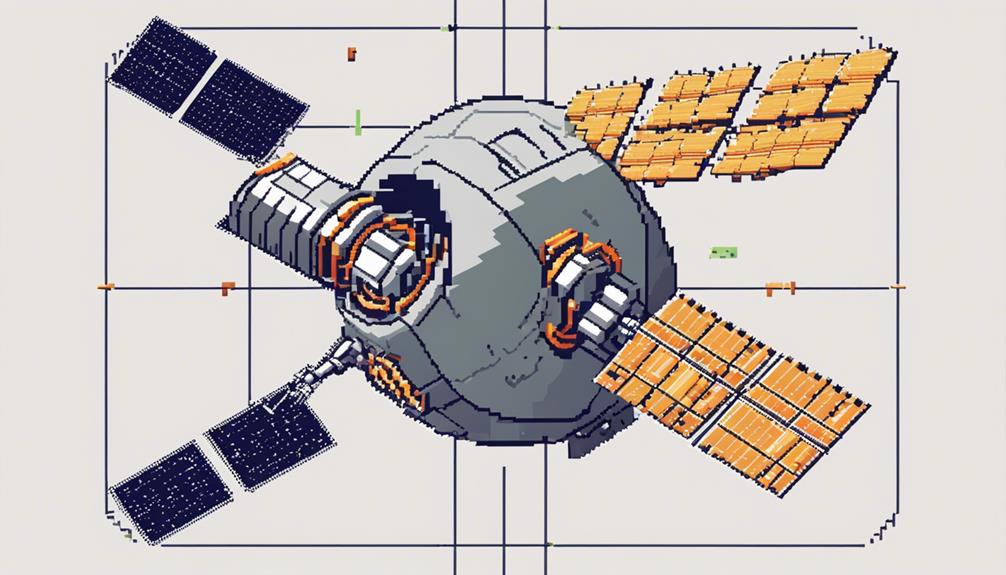
Satellite Telemetry, Tracking, and Command (TT&C) systems play a critical role in the maintenance of satellite connectivity with Earth, ensuring the precise operation and oversight of satellites in orbit. Telemetry is fundamental in this process, facilitating the downlink of essential data from the satellite to the control center on Earth. This data includes vital information about the satellite's health, status, and performance metrics, allowing operators to monitor its condition and make informed decisions regarding its operation.
Tracking within TT&C systems is another pivotal aspect, enabling the determination of the satellite's position and trajectory. By continuously tracking the satellite's movement relative to Earth, operators can ensure that it stays within its designated orbit and adjust its path if necessary to avoid collisions or drift. This real-time tracking capability is essential for maintaining satellite operations and ensuring their efficiency and safety.
Moreover, the commanding function within TT&C systems empowers operators to send instructions to the satellite, directing it to perform specific tasks or maneuvers. These commands are crucial for executing mission objectives, adjusting the satellite's orientation, or activating certain systems onboard. The control center plays a central role in coordinating these commands and ensuring they are accurately transmitted to the satellite for execution, thereby maintaining the satellite's functionality and fulfilling its intended purpose.
Components of TT&C Systems
Given the critical role of Satellite Telemetry, Tracking, and Command (TT&C) systems in ensuring the operational efficiency and safety of satellites in orbit, it is imperative to understand the intricate components that constitute these systems for effective satellite management.
The telemetry subsystem plays a crucial role in satellite monitoring by measuring various parameters such as pressure and temperature. This subsystem collects essential data that is transmitted as telemetry data to the earth station for analysis and control. On the other hand, the tracking subsystem is responsible for determining the satellite's position and orbit. It utilizes data from velocity and acceleration sensors to accurately track the satellite's movements in space.
In addition to telemetry and tracking, the commanding subsystem is equally vital. This subsystem is responsible for launching satellites into orbit, adjusting their altitude, and controlling the communication subsystem based on received instructions. It receives commands from the earth station and executes them to make operational adjustments to the satellite.
Telemetry Data Transmission Methods
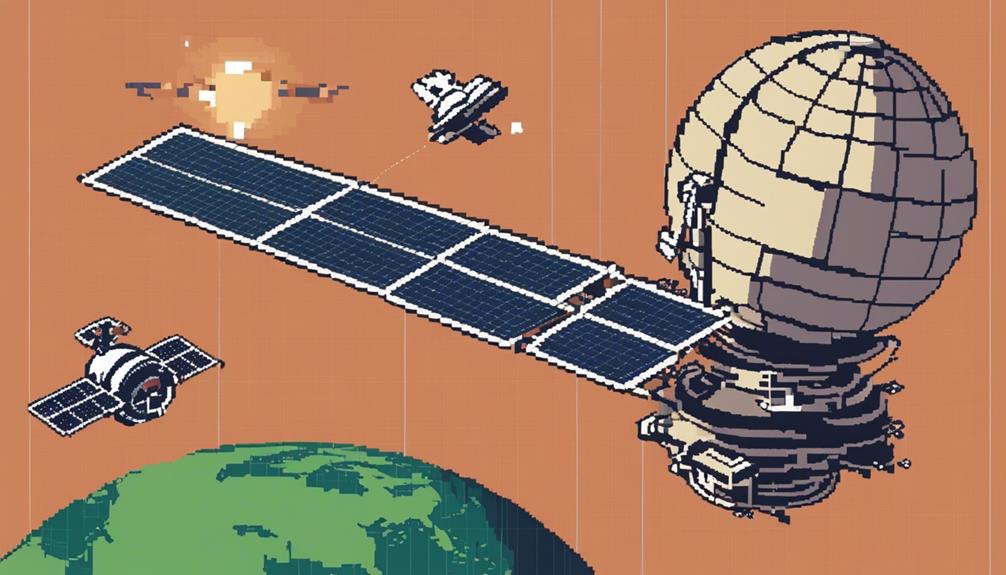
How are telemetry data transmission methods such as Frequency Shift Keying (FSK) and Phase Shift Keying (PSK) utilized in encoding and transmitting satellite data for efficient communication? Telemetry data transmission methods play a crucial role in ensuring effective communication between satellites and Earth stations. Frequency Shift Keying (FSK) and Phase Shift Keying (PSK) are commonly used modulation techniques in satellite communication systems to encode and transmit telemetry data accurately and reliably.
- FSK and PSK are modulation techniques that alter the frequency or phase of a carrier signal to represent digital data.
- Telemetry subsystems on satellites utilize FSK and PSK to modulate sensor data into signals for transmission to Earth stations.
- FSK involves shifting the carrier signal's frequency between two predefined values to convey binary information.
- PSK alters the phase of the carrier signal to represent binary data, with different phase shifts corresponding to different bit values.
These methods enable the efficient transmission of telemetry data over long distances in the space environment, ensuring that critical information from the satellite's sensors reaches the ground station accurately. By implementing FSK and PSK within telemetry subsystems, satellites can communicate essential data for monitoring parameters and ensuring the proper functioning of onboard systems.
Satellite Tracking Technologies
Satellite tracking technologies are essential for determining the exact location and trajectory of satellites in orbit through the analysis of telemetry data. These technologies rely on sophisticated tracking subsystems that interpret data from sensors measuring velocity and acceleration to pinpoint satellite positions accurately. Ground station tracking systems are integral in establishing the satellite's relative position by calculating range and look angles for effective communication and control.
Tracking Methods Overview
Utilizing a combination of ground-based radar systems, GPS receivers, and optical tracking methods, satellite tracking technologies employ various advanced techniques to precisely monitor the positions and movements of orbiting satellites. These methods include:
- Doppler tracking: Measures frequency shifts in signals for precise location determination of satellites.
- Two-line element sets (TLEs): Provide orbital data for tracking satellites based on their predicted positions.
- Laser ranging systems: Use reflected laser beams to calculate satellite distances with high accuracy.
- Inertial navigation systems: Provide continuous position updates without external inputs.
These tracking methods play a crucial role in ensuring the accurate monitoring and control of satellites in orbit.
GPS Satellite Tracking
Building upon the foundation of precise tracking methods discussed previously, GPS satellite tracking stands as a cornerstone technology, leveraging a constellation of satellites to deliver highly accurate positioning data on Earth. The GPS system functions by measuring the time it takes for signals to travel from satellites to ground receivers, allowing for precise calculations of position through triangulation. These satellites continuously transmit signals containing their exact location and time information, enabling receivers to determine their coordinates with exceptional accuracy. GPS satellite tracking plays a vital role in various applications such as navigation, surveying, and timing, where precise location information is crucial. Additionally, GPS technology is utilized not only on Earth but also in deep space missions where a satellite performs ranging signals.
| GPS Satellite Tracking | ||
|---|---|---|
| Highly Accurate | Triangulation Method | Essential Technology |
Ground Station Communication
Ground station communication plays a pivotal role in the seamless operation and control of satellite tracking technologies by facilitating the reception of telemetry data and the transmission of essential command signals.
- Communication between ground stations and satellites takes place to receive telemetry data and tracking signals for monitoring and control.
- Command signals are used to send specific functions, adjustments, or maneuvers from ground stations to satellites.
- The telemetry data received includes vital information like satellite health status, sensor readings, and operational data for monitoring and analysis.
- Ground station communication is crucial for maintaining connectivity, controlling satellite functions, and ensuring mission success.
Ground Station Command Capabilities
Command capabilities are pivotal in facilitating the remote management and control of satellite functions from ground stations. Ground station command capabilities involve sending instructions to satellites for various functions such as orbit adjustments and payload operations. These commands are transmitted from the ground station to the satellite's commanding subsystem for execution. Ground stations use sophisticated protocols to ensure that command signals are accurately received and acted upon by the satellite. Command capabilities play a crucial role in maintaining and controlling the behavior of satellites in orbit. Ground station operators have the ability to remotely control and manage satellite activities through command capabilities.
—
| Command Verification, Error Detection | Command Execution, Response Time | Command Protocols, Data Integrity |
|---|---|---|
| Ensures commands are accurately received and interpreted by the satellite | Timely execution of commands to achieve desired satellite actions | Protocols in place to maintain the integrity and security of command data |
| Validates the correctness of commands to prevent errors in satellite operations | Minimizing response time for critical commands | Ensuring data integrity during command transmission |
| Detects and rectifies errors that may occur during command transmission | Monitoring and optimizing response times for efficient satellite operations | Data encryption and authentication to prevent unauthorized command access |
—
Role of Antennas in TT&C
Antennas are fundamental components of TT&C systems, facilitating the exchange of signals between satellites and ground stations. The choice of antenna type is dictated by mission-specific requirements, with considerations for signal strength, coverage, and data transfer rates. Precision in tracking satellites is pivotal for accurate telemetry data reception and command transmission, highlighting the critical role antennas play in ensuring effective satellite communication.
Antenna Types Used
In the realm of Satellite Telemetry, Tracking, and Command (TT&C), the diverse array of antenna types plays a crucial role in facilitating various communication needs across different mission scopes.
- Phased array technology enables flexible beam steering and simultaneous tracking of multiple satellites.
- Parabolic antennas offer high directivity for precise pointing and tracking of satellites in orbit.
- Helical antennas are utilized for circular polarization, supporting telemetry and command functions in specific mission scenarios.
- Antenna polarization techniques are crucial for optimizing signal reception and transmission efficiency in satellite communication systems.
Signal Strength Considerations
Within Satellite Telemetry, Tracking, and Command (TT&C) systems, the consideration of signal strength, particularly in relation to antenna performance, is paramount for ensuring seamless communication between satellites and ground stations. Signal strength optimization is crucial for reliable telemetry data, tracking signals, and command transmissions. Environmental factors can impact signal reliability, making adaptive antenna technologies essential for adjusting to changing conditions during TT&C operations. Antenna beamwidth considerations also play a significant role in maintaining strong communication links, as they determine the coverage area and focus of the antenna's signal. By understanding these factors and utilizing adaptive technologies, satellite operators can enhance signal tracking accuracy and overall performance in TT&C systems.
Tracking Accuracy Importance
The pivotal role of precise tracking accuracy in Satellite Telemetry, Tracking, and Command (TT&C) systems hinges significantly on the effectiveness of antenna systems.
- Importance: Tracking accuracy is paramount for maintaining continuous communication with satellites, enabling precise orbit determination and control.
- Precision: High-performance antennas offer directional sensitivity crucial for accurately tracking satellites during their orbits.
- Efficiency: Antennas designed to handle various frequencies and signal strengths ensure effective satellite tracking in different mission scenarios.
- Reliability: Advanced antenna technologies enhance overall tracking capabilities, contributing to the success of satellite missions requiring precise telemetry and command functions.
Data Encryption in Satellite Communication
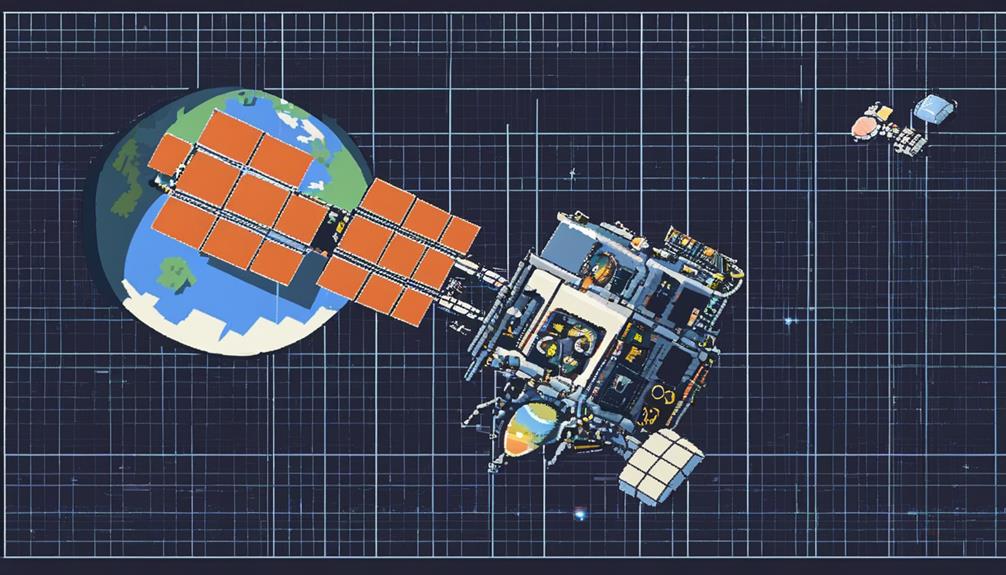
Utilizing advanced encryption standards such as AES is imperative in ensuring the secure transmission of sensitive telemetry, tracking, and command data in satellite communication. Data encryption plays a crucial role in maintaining the confidentiality and integrity of information exchanged between satellites and ground stations. Encryption key management is a fundamental aspect of data security, where encryption keys are used to encode and decode telemetry data. By implementing robust encryption protocols, data transmission security is enhanced, preventing unauthorized access and potential tampering of critical commands sent to satellites.
The utilization of encryption techniques like AES helps in safeguarding satellite operations against cyber threats. Secure encryption mechanisms not only protect the telemetry, tracking, and command data but also contribute to the overall resilience of satellite communication systems. Cyber threat prevention is a primary objective in satellite communication, and encryption serves as a foundational defense mechanism in mitigating risks associated with unauthorized intrusions.
Real-Time Monitoring and Control
Real-time monitoring in satellite systems involves the continuous tracking of critical parameters such as satellite health and status. Control commands are executed based on real-time telemetry data analysis, allowing for immediate adjustments to satellite functions. Monitoring systems play a crucial role in tracking satellite position, velocity, and operational parameters, ensuring swift responses to changing conditions.
Live Data Updates
In the realm of satellite telemetry, achieving optimal operational efficiency hinges on the seamless integration of live data updates for monitoring and controlling satellite systems. Real-time monitoring in satellite telemetry involves continuous updates on satellite health, status, and performance. Live data updates enable operators to track satellite position, velocity, and orientation for precise control. Immediate telemetry feedback allows for quick response to anomalies and adjustments to satellite operations. Real-time tracking information assists in maintaining satellite connectivity and optimizing communication links. Instantaneous command execution based on live data updates ensures efficient and reliable satellite operations. To enhance these processes, data visualization techniques, remote troubleshooting methods, and telemetry anomaly detection play crucial roles in ensuring smooth satellite operations.
Remote Command Execution
Remote command execution in satellite telemetry facilitates the real-time monitoring and control of satellite functions directly from the ground station. Operators utilize this capability to send commands promptly, such as adjusting satellite orbits, activating systems, or resolving issues. The commanding subsystem transmits these commands to the satellite for immediate execution. Command verification is crucial to ensure that instructions are correctly received and implemented. This real-time monitoring feature allows operators to receive feedback on the status of executed commands promptly. Additionally, remote command execution enables emergency response actions to be swiftly initiated and facilitates the deployment of software updates to enhance satellite performance and address any potential vulnerabilities. This functionality is fundamental for ensuring the operational efficiency and longevity of satellites in orbit.
TT&C System Integration Challenges
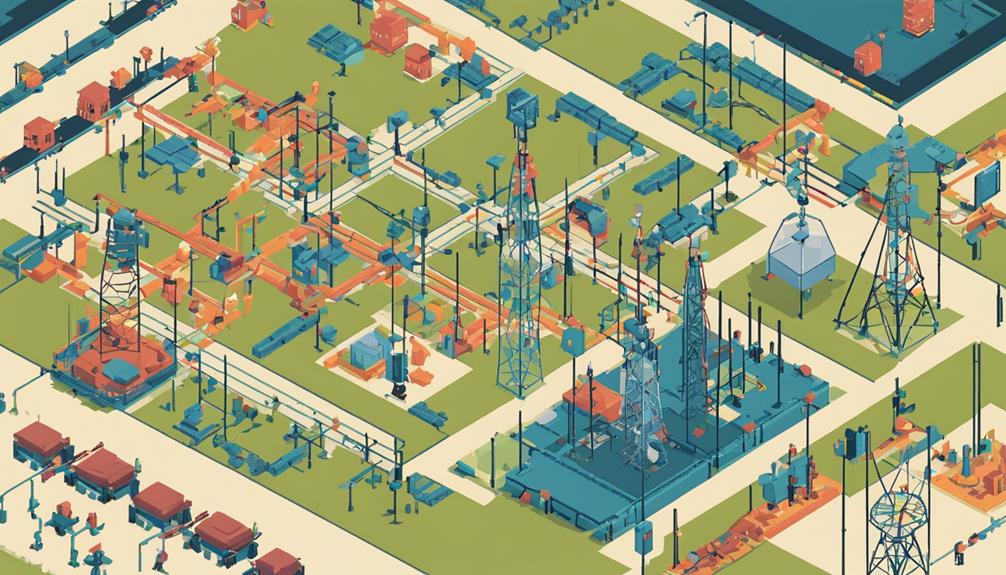
Facing compatibility issues among various satellite components, the integration of TT&C systems presents intricate challenges that demand meticulous attention to detail. The complexities in TT&C system integration encompass various aspects that require careful consideration:
- Integration complexities, synchronization challenges: Ensuring seamless communication between telemetry, tracking, and commanding subsystems is crucial for the successful operation of the satellite. Synchronization of data transmission and reception timings is essential to achieve accurate satellite control.
- Power management, resource allocation: Managing power distribution and resource allocation among TT&C subsystems is a critical integration hurdle. Efficient power utilization and allocation of resources are vital to sustain the continuous operation of the satellite systems.
- Signal latency, data processing delays: Addressing signal latency and data processing delays is paramount for the effective integration of TT&C systems. Minimizing signal latency and optimizing data processing capabilities are essential for real-time communication and control of the satellite.
Overcoming these challenges requires a comprehensive understanding of the intricate relationships between different components of the TT&C system. By addressing integration complexities, power management issues, and signal latency challenges, satellite operators can enhance the overall performance and reliability of the satellite communication network.
Remote Satellite Operations Management
Efficient management of satellite operations involves the meticulous monitoring of satellite status, health, and function from a dedicated ground control station. Remote satellite operations management is essential for ensuring optimal satellite performance, operational efficiency, and data accuracy. Operators rely on continuous monitoring to assess satellite health, track its position, and evaluate performance metrics derived from telemetry data.
Satellite performance is a critical aspect of remote satellite operations management. Monitoring key performance indicators allows operators to gauge the effectiveness of satellite functions and make informed decisions regarding adjustments or troubleshooting. Operational efficiency is another key focus area in managing satellite operations remotely. By streamlining processes, minimizing downtime, and optimizing resource allocation, operational efficiency can be enhanced to maximize satellite productivity.
Data accuracy is paramount in remote satellite operations management. Telemetry data provides crucial insights into satellite health, position, and performance, enabling operators to make informed decisions and execute precise commands. Maintaining data accuracy ensures the reliability of information used for monitoring and controlling satellite functions.
Future Trends in Satellite TT&C
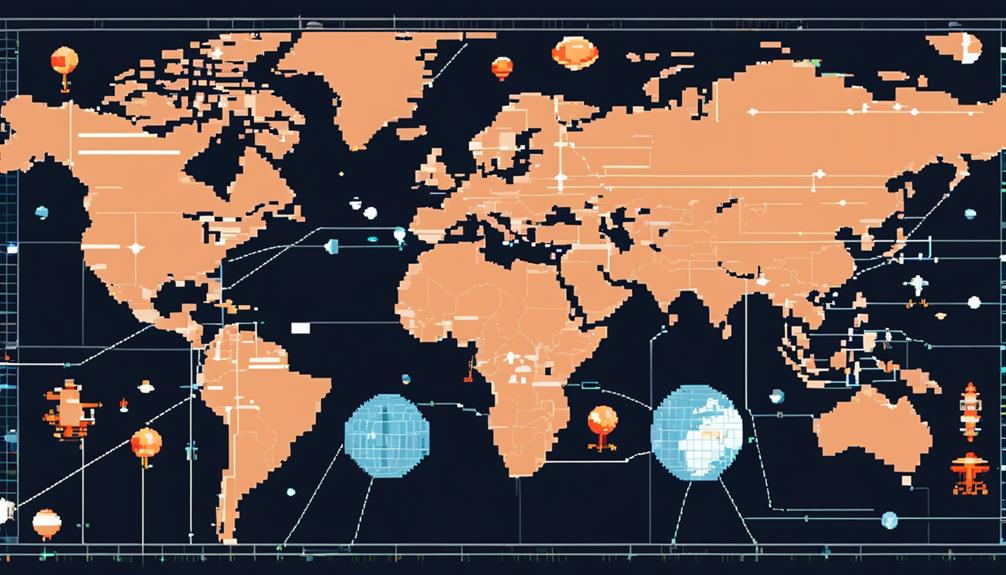
Future trends in Satellite TT&C are rapidly evolving, focusing on automation and the integration of artificial intelligence into telemetry, tracking, and command systems. These advancements aim to enhance the efficiency and reliability of satellite operations, enabling more autonomous decision-making processes. The integration of AI algorithms and automation technologies is poised to revolutionize how satellite missions are conducted and monitored in the near future.
Automation in TT&C
Advancing satellite telemetry, tracking, and command (TT&C) systems involves the integration of autonomous transponders tailored for diverse mission requirements. In the realm of automation in TT&C, several key trends are shaping the future landscape:
- Implementation of autonomous transponders leveraging machine learning for enhanced decision-making capabilities.
- Utilization of software-defined radio transponders to enable efficient testing automation processes.
- Addressing miniaturization challenges in deep space transponders while striving for optimal performance levels.
- Designing flexible multi-mission TT&C transponders capable of adapting to a wide range of scenarios in satellite operations. These trends signify a shift towards more advanced and adaptable TT&C systems that are crucial for the evolving demands of satellite missions.
AI Integration
Integrating artificial intelligence (AI) into satellite telemetry, tracking, and command (TT&C) systems revolutionizes operational efficiency through automated anomaly detection and resolution, enhancing overall mission success rates. AI applications enable machine learning algorithms to predict maintenance needs, reducing downtime and improving satellite performance. Real-time data analysis facilitated by AI integration optimizes satellite operations in dynamic space environments, ensuring timely responses to changing conditions. The autonomous decision-making capabilities of AI further enhance system adaptability to evolving mission requirements. The integration of AI in satellite TT&C systems paves the way for intelligent, self-learning systems that advance telemetry, tracking, and command operations to new levels of sophistication and effectiveness in the realm of space exploration.
Security Measures in TT&C Systems
Security measures in TT&C systems are crucial for safeguarding communication links and preventing unauthorized access. TT&C systems implement various techniques to enhance security, such as:
- Signal Authentication: Signal authentication is a key security measure in TT&C systems. By verifying the integrity and authenticity of the signals, unauthorized access and spoofing can be mitigated effectively.
- Error Reduction: Error reduction techniques like Adaptive Coding and Modulation (ACM) schemes play a vital role in enhancing security. These techniques help in improving the reliability of data transmission and reduce the risk of errors or data corruption.
- Encryption Techniques: Encryption is widely used in TT&C systems to secure the communication links. Advanced encryption methods ensure that the data transmitted between the satellite and the ground station remains confidential and protected from malicious entities.
- RF Signal Fingerprinting: Authentication methods based on radio signal fingerprinting are being explored to prevent spoofing of satellite RF signals. By uniquely identifying each signal, these methods add an extra layer of security to the TT&C systems.
These security measures collectively contribute to the robustness of TT&C systems, ensuring the integrity and confidentiality of communication links between satellites and ground stations.
Satellite Link Budget Analysis
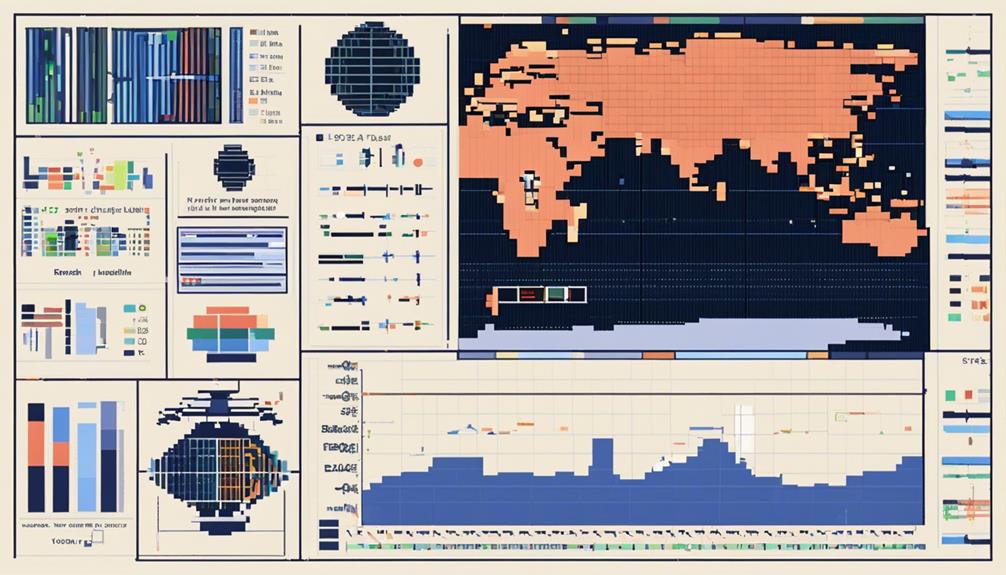
To ensure optimal performance and reliability of satellite communication systems, a thorough satellite link budget analysis is conducted to assess signal strength and quality considering various factors such as transmitter power, antenna gains, cable losses, and atmospheric effects. Link budget calculations play a pivotal role in determining the overall performance of the communication link by accounting for the power levels at different stages of the transmission and reception process. Performance analysis techniques are employed to evaluate the feasibility and reliability of the satellite communication link under diverse operational scenarios.
Signal optimization strategies are implemented based on the outcomes of the link budget analysis to enhance the efficiency of data transmission and reception between the satellite and ground stations. By fine-tuning system parameters in accordance with the analysis results, reliable telemetry, tracking, and commanding operations can be ensured. This meticulous approach is essential for designing, testing, and maintaining satellite communication systems that are robust and capable of meeting the demands of telemetry, tracking, and command applications.
Regulatory Compliance in Satellite Communication
Regulatory compliance in satellite communication necessitates strict adherence to established international standards, such as ITU regulations, to ensure the seamless operation and coordination of satellite systems. Compliance challenges in this field are multifaceted and require a comprehensive approach to meet regulatory requirements effectively. Key aspects of regulatory compliance in satellite communication include:
- Spectrum Allocation Rules: Satellite operators must meticulously adhere to spectrum allocation rules to prevent interference with other services sharing the same frequency bands. Failure to comply with these rules can result in disruptions to critical communication systems and services.
- Licensing Requirements: The legal operation of satellite systems is contingent upon obtaining the necessary licenses, which can vary significantly from country to country. Understanding and fulfilling these licensing requirements are paramount for satellite operators to operate within the confines of the law.
- Data Protection and Privacy Regulations: Given the sensitive nature of telemetry data transmitted by satellites, compliance with data protection and privacy regulations is imperative. Safeguarding this data from unauthorized access or breaches is essential to maintain the integrity and confidentiality of satellite communications.
- Safety and Security Standards: Satellite communication systems must meet stringent safety and security standards to mitigate the risks of unauthorized access and misuse of data. Implementing robust security measures is vital to safeguard against potential threats and vulnerabilities in satellite networks.
Frequently Asked Questions
What Is Telemetry Tracking and Command in Satellite Communication?
Satellite control, operation in space technology involves managing satellite functions to achieve mission goals. It encompasses data transmission, reception for monitoring and controlling satellite activities. Remote monitoring, control allows operators to ensure proper satellite performance from ground stations. The integration of these elements forms the foundation of satellite communication systems, enabling efficient and effective satellite operations.
What Is Command and Telemetry?
Command and telemetry are integral aspects of satellite operations. Command involves the execution of instructions for real-time monitoring and operational control of the satellite. On the other hand, telemetry focuses on data transmission for remote control and signal reception. These functions are crucial for ensuring effective communication with the satellite, enabling operators to manage its functions, monitor its health, and maintain operational efficiency.
What Is Tt&C in Satellite?
The TT&C system in satellites encompasses a suite of operations crucial for satellite operations. It facilitates communication, control, and monitoring between the satellite and ground stations. This system is instrumental in ensuring the transmission of telemetry data, tracking the satellite's location, and executing command functions to maintain the satellite's operations in space. Ground station operations rely heavily on the TT&C system to establish and maintain connectivity with satellites for efficient data exchange and control.
What Is Satellite Telemetry?
Satellite telemetry involves the data collection, signal transmission, and orbit monitoring of a satellite. It encompasses the process of gathering various parameters such as temperature, pressure, and operational status in real-time. This data is crucial for evaluating the satellite's health and performance throughout its mission. Utilizing modulation techniques like Frequency Shift Keying (FSK) or Phase Shift Keying (PSK), telemetry systems encode and transmit this information to ground stations for analysis and control purposes.
